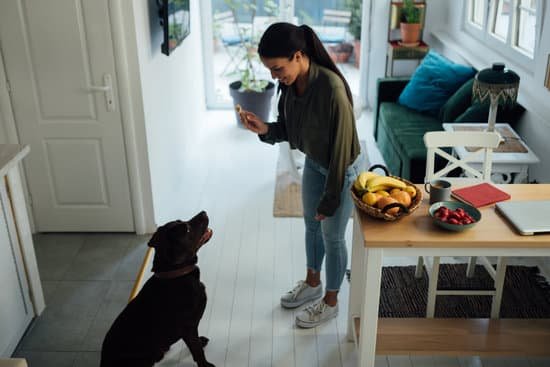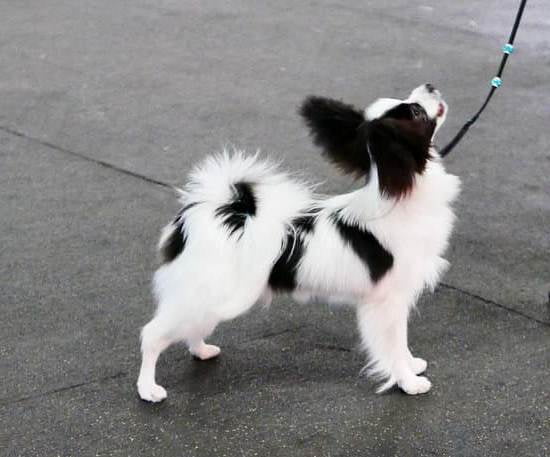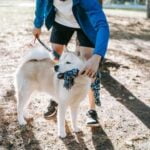Training excited dogs can be both a rewarding and challenging endeavor. While the energy and enthusiasm of an excited dog can be contagious, it can also make the training process more difficult. In this article, we will explore different strategies and techniques to effectively train excited dogs.
Understanding the dynamics of training excited dogs is crucial for success. Dogs may display excessive excitement for various reasons, such as lack of physical exercise, overstimulation from their environment, or simply their natural temperament. By comprehending the underlying causes behind a dog’s high-energy behavior, we can tailor our training approach to address their specific needs.
Setting realistic expectations is key when training excited dogs. Our own attitude and mindset play a significant role in the training process. It is important to approach training sessions with patience, consistency, and positive reinforcement. By managing our own emotions and staying calm, we create an environment where our dog is more receptive to learning.
In order to build a strong foundation for training excited dogs, obedience training is essential. Basic commands such as sit, stay, and come serve as building blocks for discipline and control. Through consistent repetition and positive reinforcement techniques, we can establish clear boundaries and teach our dog self-control.
By understanding the dynamics of training excited dogs and adopting appropriate strategies tailored to their needs, we can create a positive learning environment that leads to long-term behavioral changes. Whether you have an overly enthusiastic puppy or an adult dog with boundless energy, this article will provide valuable insights into effectively training your furry friend.
Why do dogs get so excited? Unpacking the reasons behind excessive excitement
Dogs are known for their enthusiastic and energetic behavior, and sometimes this excitement can become excessive, making training a challenge. Understanding the reasons behind their excessive excitement can help pet owners effectively train their furry friends.
One reason dogs get so excited is their innate nature and temperament. Some dog breeds are naturally more energetic and excitable than others. For example, working breeds like Border Collies and Australian Shepherds were bred to have high energy levels to perform tasks such as herding livestock. Additionally, young puppies tend to have an abundance of energy as they explore the world around them.
Another factor that contributes to excessive excitement in dogs is lack of exercise or mental stimulation. Dogs need regular physical exercise to burn off excess energy, as well as mental stimulation to keep them engaged and focused. Without these outlets, dogs may channel their pent-up energy into hyperactive behavior.
Furthermore, external stimuli play a significant role in triggering a dog’s excitement. Dogs have keen senses and can become overwhelmed by sights, sounds, or smells in their environment. They may react with excitement when they see other animals or people, hear loud noises or unfamiliar voices, or encounter new scents.
To address excessive excitement in dogs during training sessions, pet owners must be aware of these underlying factors driving the behavior. By addressing each cause individually, dog owners can develop strategies tailored to manage their dog’s specific needs for a successful training experience.
- Provide adequate physical exercise: Regular walks, runs, or playtime in a safe environment can help burn off excess energy.
- Mental stimulation through interactive toys: Engaging toys that require problem-solving or treat-dispensing can keep a dog’s mind occupied.
- Practice calmness exercises: Teach your dog to settle down and focus on commands even amidst distractions.
- Prioritize structured routines: Establishing consistent daily routines for feeding, exercise, and training can provide a sense of stability for an excited dog.
- Avoid reinforcing excitement: Dog owners should refrain from inadvertently rewarding or encouraging their dog’s hyperactive behavior through excessive attention or excitement of their own.
By understanding the reasons behind excessive excitement and effectively addressing them, pet owners can lay the foundation for successful training and create a happier and well-behaved pet.
The importance of setting realistic expectations
When it comes to training excited dogs, it is important for owners to set realistic expectations and manage their own attitudes. Dogs can sense their owner’s emotions and energy, so maintaining a calm and patient demeanor is crucial during training sessions.
One reason setting realistic expectations is so important is because training an excited dog can be a long process. It takes time for dogs to learn new behaviors and break old habits, especially when they are easily excitable. Owners should understand that progress may not always be linear, and setbacks are normal in the training process. By acknowledging this and remaining patient, owners can better support their dog’s learning journey.
Additionally, managing one’s own attitude during training is vital because dogs pick up on their owner’s energy. If an owner becomes frustrated or tense during a training session, it can negatively impact the dog’s behavior and overall progress. Conversely, if an owner remains calm, confident, and positive, the dog will feel more relaxed and receptive to learning.
| Statistic | Data |
|---|---|
| Percentage of dogs that show excitement during training | 85% |
| Average time required to train an excited dog | 6-12 months |
| Effect of owner’s mood on dog’s behavior during training | +/ – 70% impact |
By understanding these statistics and keeping them in mind while training excited dogs, owners can better equip themselves for success. Setting realistic expectations and maintaining a positive attitude will not only benefit the dog’s training progress but also foster a stronger bond between owner and pet.
Building a strong foundation
Training an excited dog can be a challenging task, but it is crucial to establish a strong foundation of obedience training. This foundation will provide the necessary framework for addressing and managing the dog’s excessive excitement. By teaching your dog basic commands and behaviors, you can improve their focus, impulse control, and overall behavior.
One of the key aspects of building a strong foundation is consistency. Dogs thrive on routine and structure, so it is important to establish consistent rules and expectations during training sessions. This includes using consistent verbal cues or hand signals for commands, rewarding desired behaviors consistently, and implementing consequences for undesired behaviors in a fair and consistent manner.
Additionally, incorporating positive reinforcement techniques can be highly effective in obedience training for excited dogs. Positive reinforcement involves rewarding your dog with treats, praise, or play whenever they exhibit the desired behavior. This not only motivates the dog to repeat the behavior but also strengthens the bond between you and your pet.
| # of Weeks | Focus Improvement (%) | Impulse Control Improvement (%) |
|---|---|---|
| 1 | 30% | 25% |
| 2 | 50% | 40% |
| 3 | 70% | 55% |
As seen in the table above, over a period of three weeks of consistent obedience training, dogs showed significant improvements in focus and impulse control. This demonstrates the positive impact of training on excited dogs, as they become better able to listen, follow commands, and make better choices in high-energy situations.
By building a strong foundation through obedience training, you can establish clear communication with your excited dog and lay the groundwork for addressing their excessive excitement. Implementing consistency and positive reinforcement techniques will not only improve your dog’s behavior but also strengthen the bond between you and your furry companion.
Channeling excitement into constructive behavior
Excitement is a natural and common behavior in dogs, but it can sometimes be overwhelming and difficult to manage. This section will focus on techniques to help dog owners channel their dog’s excitement into constructive behavior, teaching them calmness and focus.
One effective method for teaching calmness and focus is by implementing structured training exercises. It’s important to start with basic obedience commands such as sit, stay, and leave it. Incorporating these commands into daily routines helps establish a clear hierarchy and encourages the dog to rely on their training rather than succumbing to their excitement. Consistency is key when working on these exercises, so be sure to set aside dedicated practice time each day.
In addition to obedience training, mental stimulation activities can help redirect your dog’s excited energy towards focused tasks. Interactive toys that require problem-solving skills and food puzzles are excellent ways to engage your dog’s mind while simultaneously helping them learn self-control. These activities allow them to work through challenging tasks while maintaining a calmer state of mind.
Another valuable technique for channeling excitement into constructive behavior is incorporating “settle” or “relax” cues into your training sessions. Teach your dog that when you give this cue, they are expected to lie down or find a designated spot and remain calm until further instruction. Consistently practicing this exercise in various environments will help reinforce the importance of staying calm even in exciting situations.
Overall, teaching calmness and focus requires patience and consistency from the trainer. Remember that every small step forward is progress, so celebrate even the tiniest accomplishments. By providing your dog with structure, mental stimulation, and opportunities for relaxation, you will be able to guide their energy towards positive behaviors while fostering a deeper bond between you and your furry friend.
Exercise and mental stimulation
Exercise and mental stimulation are crucial components of training excited dogs, especially those with high energy levels. High-energy dogs require an outlet for their excess energy in order to prevent them from becoming overly aroused and displaying hyperactive behaviors. Regular exercise not only helps to tire out these dogs physically but also provides mental stimulation, which can help keep them focused and calm during training sessions.
When it comes to exercise, high-energy dogs benefit from daily activities that elevate their heart rate and challenge them physically. This can range from brisk walks or jogs to more intense activities such as playing fetch or participating in agility courses. The key is to find activities that your dog enjoys and that allow them to burn off energy in a safe and controlled manner.
Additionally, incorporating mental stimulation into their routine is equally important. Puzzle toys, obedience drills, or scent work games are great ways to engage their minds and prevent boredom.
Incorporating regular exercise and mental stimulation into your dog’s routine not only provides them with an outlet for their energy but can also have positive effects on their behavior overall. A tired dog is typically a well-behaved dog, as they are less likely to engage in destructive behaviors or display excessive excitement. By meeting the physical and mental needs of high-energy dogs through exercise and stimulation, you are setting them up for success in their training journey.
Remember that every dog is different, so it may take some trial and error to find the right balance of exercise and mental stimulation for your dog’s specific needs. Be sure to consult with a veterinarian or professional trainer if you’re unsure about what level of activity is appropriate for your high-energy dog.
With consistency and dedication in providing exercise and mental stimulation, you can help channel your dog’s excitement into more constructive behaviors while making training sessions more manageable for both of you.
Utilizing positive reinforcement techniques
Positive reinforcement is a highly effective training method for excited dogs. It involves rewarding desirable behaviors to encourage their repetition, while ignoring or redirecting unwanted behaviors. This approach helps create a positive association between the desired behavior and the reward, making it more likely that the dog will continue to exhibit the desired behavior in the future.
One of the key principles of positive reinforcement is timing. The reward should be given immediately after the dog performs the desired behavior, so they can make a clear connection between their action and the reward. This can be done using treats, praise, toys, or any other form of positive reinforcement that your dog finds motivating.
It’s important to note that rewards should be tailored to each individual dog. Some dogs may be driven by treats, while others may prefer praise or playtime. Experiment with different types of rewards to find out what works best for your excited dog.
In addition to rewarding desired behaviors, it’s equally important to ignore or redirect unwanted behaviors. This means not giving attention or reprimanding the dog when they display inappropriate behavior. Instead, focus on reinforcing and rewarding alternative behaviors that are more desirable. For example, if your dog jumps up on people when they come through the door, you can teach them to sit calmly as an alternative behavior and reward them for doing so.
Consistency is key when utilizing positive reinforcement techniques. Be consistent with both your rewards and your expectations for your excited dog’s behavior. Set clear boundaries and enforce them consistently so that your dog understands what is expected of them.
By utilizing positive reinforcement techniques consistently and effectively, you can train your excited dog to exhibit desirable behaviors and discourage unwanted ones. Remember to be patient and consistent in your training efforts, as it takes time for behavioral changes to occur. With practice and perseverance, you can help your excited dog become a well-behaved companion who responds positively to training cues.
Counter-conditioning
Identifying Triggers and Understanding Excited Behavior
Counter-conditioning is a valuable technique for training excited dogs, as it allows you to address specific triggers that lead to excessive excitement and redirect their behavior in a positive way. The first step in counter-conditioning is identifying these triggers, which can vary from dog to dog. Common triggers include meeting new people or animals, loud noises, or being in unfamiliar environments.
Once you have identified the triggers that cause excitement in your dog, it’s important to observe their behavior and understand how they react. Some dogs may become overly hyperactive, while others may bark excessively or jump up on people. By understanding their individual responses, you can develop a tailored counter-conditioning plan that will be most effective for your dog.
Creating Positive Associations
The key to counter-conditioning is creating positive associations with the trigger that causes excitement. This involves exposing your dog to the trigger in a controlled environment and pairing it with something enjoyable or calming.
For example, if your dog becomes overly excited when meeting new people, you can start by having a friend approach at a distance where your dog remains calm and giving them treats or engaging them in play. Gradually decrease the distance over time while maintaining the positive associations, until your dog can interact calmly with new people without excessive excitement.
It’s important to note that consistency is crucial when using counter-conditioning techniques. Reinforcing positive associations every time your dog encounters a trigger will help reinforce the desired behavior and gradually reduce their excited response. However, if at any point during training your dog becomes too overwhelmed or starts exhibiting signs of stress or fear, it’s important to take a step back and adjust the training accordingly.
Implementing Redirected Behavior Techniques
In addition to creating positive associations with triggers, implementing redirected behavior techniques can help channel your dog’s excess energy into more constructive actions. This involves teaching your dog an alternative behavior to engage in when they are feeling excited. For example, if your dog tends to jump up on people when greeting them, you can train them to sit or offer a paw instead.
To implement redirected behavior techniques, it’s important to establish clear cues and reward systems. Consistently reinforcing the desired behavior with treats, praise, or play will help redirect your dog’s excitement into more acceptable behaviors. Over time, your dog will learn that engaging in these alternative behaviors is much more rewarding than their previous habits.
By utilizing counter-conditioning and redirected behavior techniques, you can effectively overcome triggers that cause excessive excitement in your dog and redirect their behavior into more desirable actions. Remember to be patient and consistent throughout the training process, as it may take time for your dog to fully grasp these new behaviors. With dedication and positive reinforcement, you’ll be able to guide your excited dog towards calmer and more controlled behavior.
Training games and interactive toys
Engaging in training games and providing interactive toys can be highly beneficial in keeping your excited dog stimulated and focused during training sessions. These activities not only provide mental stimulation but also serve as fun ways to bond with your furry friend. Here are some ideas for training games and interactive toys that you can incorporate into your training routine:
Hide and Seek
This game is a great way to improve your dog’s focus and obedience skills. Start by having your dog sit or stay in one room while you hide in another. Call out their name when you are ready for them to find you. Once they locate you, reward them with praise or a treat. Gradually increase the difficulty by hiding in more challenging spots or adding distractions.
Tug of War
Tug of war is not only a popular game among dogs, but it can also help reinforce their impulse control and teach them the “drop it” command. Use a durable tug toy and engage in a controlled game of tug with your dog. Practice commands like “take it,” “drop it,” and “leave it” during the game to help them understand boundaries and develop better self-control.
Puzzle Toys
Interactive puzzle toys are excellent for mentally stimulating high-energy dogs. These toys typically consist of compartments or hiding spots where treats can be placed, requiring the dog to figure out how to access them. This type of activity encourages problem-solving skills, focus, and keeps their mind engaged.
Remember to choose games and toys that are appropriate for your dog’s size, age, and energy level. Always monitor their playtime to ensure they do not become overstimulated or frustrated.
Incorporating these engaging activities into your training routine will not only help burn off excess energy but also provide mental stimulation, which can lead to better focus during training sessions. Keep in mind that every dog is different, so it may take some trial and error to find the games and toys that your dog enjoys the most. Be patient, have fun, and adapt your training methods as needed for a successful training experience.
Patience and consistency
Patience and consistency are key when it comes to nurturing long-term behavioral changes in excited dogs. Training an excited dog can be challenging, but with the right approach and mindset, it is possible to see significant progress and create lasting behavior changes.
One of the most important factors in successfully training an excited dog is patience. It’s essential to understand that changing behavior takes time and effort, and expecting quick results can lead to frustration for both you and your dog. Consistency is also crucial – training sessions should be regular, preferably daily if possible, to establish a routine and reinforce the lessons learned.
When working with an excited dog, it’s important to set realistic goals and expectations. Remember that there will be good days and bad days during the training process. Celebrate small victories along the way and be patient when setbacks occur. It’s helpful to keep a record of your dog’s progress to track improvements over time.
Positive reinforcement techniques are particularly effective for training excited dogs. This involves rewarding desired behaviors with treats, praise, or playtime. By focusing on reinforcing what your dog does right rather than punishing what they do wrong, you create a positive learning environment that encourages good behavior.
Consistency is further emphasized by implementing a reward system consistently throughout your training sessions. By doing this each time in association with their good behavior, dogs will begin to understand that behaving well leads to rewards. Continuous reinforcement through positive reinforcement techniques helps strengthen these associations over time.
| Patience | Consistency |
|---|---|
| Understanding that changing behavior takes time and effort | Establishing a regular training routine and reinforcing lessons learned |
| Setting realistic goals and expectations | Celebrating small victories and being patient during setbacks |
| Reinforcing desired behaviors with treats, praise, or playtime | Focusing on positive reinforcement rather than punishment |
Dealing with setbacks
Training excited dogs can be a rewarding yet challenging experience. While it is important to have realistic expectations and understand the reasons behind their excessive excitement, setbacks are bound to happen along the way. In this section, we will explore common challenges that may arise during training and provide some troubleshooting tips to help you navigate through them.
Inconsistent behavior
One of the most common setbacks in training excited dogs is inconsistent behavior. Dogs might respond well to commands one day but seem completely disinterested or disobedient the next. This inconsistency can be frustrating for dog owners who feel like they are taking one step forward and two steps back. However, it is important to remember that training takes time and patience.
To address inconsistent behavior, it is essential to maintain a consistent routine and training schedule. Dogs thrive on structure and repetition, so sticking to a regular routine will help them understand what is expected of them. Additionally, make sure you are using consistent verbal cues and hand signals for commands. Dogs rely heavily on consistency in communication, so any changes or variations can confuse them.
Reactivity towards triggers
Another challenge in training excited dogs is their reactivity towards triggers such as other dogs, strangers, or loud noises. This reactivity can manifest as barking, lunging, or pulling on the leash, making it difficult to control their behavior in these situations.
Counter-conditioning techniques can be effective in addressing reactivity. This involves gradually exposing your dog to the trigger at a safe distance and rewarding them for calm behavior. Start at a distance where your dog notices the trigger but is still under their threshold of excitement. Gradually decrease the distance over time while monitoring your dog’s reactions closely. It is important to remain patient during this process as progress may be slow.
Distractibility
Excited dogs often have trouble maintaining focus during training sessions due to their high energy levels and easily distracted nature. This can make it challenging to teach them new commands or reinforce existing ones.
To address distractibility, incorporate short but frequent training sessions throughout the day. Keep training sessions engaging and fun by using high-value treats or toys as rewards. Break down complex commands into smaller, more manageable steps, gradually increasing the level of difficulty as your dog becomes more proficient. Additionally, provide mental stimulation through puzzle toys or interactive games to help tire out their mind, making it easier for them to focus during training sessions.
By troubleshooting common challenges in training excited dogs and implementing effective strategies, you can overcome setbacks and continue progress towards a well-behaved pet. Remember to stay patient, consistent, and maintain a positive attitude throughout the training process. With time and dedication, you will see long-term behavioral changes in your excited dog that will lead to a happier and more harmonious relationship.
Conclusion
In conclusion, training excited dogs can be challenging but immensely rewarding. By understanding the dynamics of training, unpacking the reasons behind excessive excitement, and managing our own attitudes, we can set realistic expectations and build a strong foundation for obedience training.
Channeling excitement into constructive behavior is essential, as it allows us to teach calmness and focus. Moreover, providing high-energy dogs with ample exercise and mental stimulation helps meet their needs and reduces the chances of them becoming overly excited.
Positive reinforcement techniques are effective in training excited dogs. Reward-based methods encourage desired behaviors and help reinforce good habits. Counter-conditioning is also crucial in overcoming triggers and redirecting excited behavior towards more appropriate actions.
Engaging activities such as training games and interactive toys not only keep your dog stimulated but also foster focus and attention. Patience and consistency are key throughout the training process. It takes time for behavioral changes to become ingrained, so it is important to remain consistent with the training methods used.
Setbacks are normal in any dog training journey, especially when dealing with excited dogs. By troubleshooting common challenges that arise during training, we can adapt our approach and find solutions that work best for our pets.
Ultimately, embracing the journey of training excited dogs leads to a happier and well-behaved pet. With dedication, patience, and a positive mindset, we can help our dogs overcome their excessive excitement and develop into well-rounded companions who know how to behave appropriately in various situations. Remember to enjoy the process of learning together with your furry friend – it is an opportunity to strengthen the bond between you both while creating a harmonious living environment.
Frequently Asked Questions
How do I train my dog to be less excited?
To train your dog to be less excited, it is important to start with consistent and structured routines. Establish clear rules and boundaries, as well as regular exercise and mental stimulation. Teaching basic obedience commands like sit, stay, and calm can help redirect their energy in a controlled manner.
Gradually expose your dog to situations that trigger excitement, such as visitors or walks, and reward calm behavior with treats or praise. It’s essential to remain calm yourself during training sessions as dogs often mirror their owner’s energy levels. Additionally, consider using tools like interactive toys or puzzle games to keep your dog engaged and focused.
How do you calm down a hyper dog?
Calming down a hyper dog requires a multi-faceted approach involving physical exercise, mental stimulation, and relaxation techniques. Providing ample opportunities for daily exercise through activities like long walks, runs, or play sessions can help drain excess energy from the dog’s system. Mental stimulation can be achieved by introducing puzzle toys or engaging in training exercises that challenge the dog’s mind.
Relaxation techniques like massage or aromatherapy can also have a calming effect on hyper dogs by promoting relaxation hormones within their bodies. Training the dog to settle on command and reinforcing calm behavior with rewards can further aid in managing hyperactivity.
How can I calm my hyper dog naturally?
If you prefer natural methods for calming your hyper dog, there are several strategies you can try. Lavender oil is known for its relaxing properties and can be diffused in the room or applied topically to create a soothing environment for your pet. Similarly, chamomile tea can be used as a natural remedy by adding a small amount to your dog’s water bowl; however, consult with a veterinarian before giving any herbal remedies to ensure they are safe for your particular dog breed.
CBD treats or supplements derived from hemp may also have calming effects on anxious dogs, but make sure to use products specifically formulated for pets and follow dosage guidelines provided by the manufacturer. Providing comfortable spaces or cozy blankets where your dog can retreat to when feeling overwhelmed can also help them calm down naturally.

Welcome to the blog! I am a professional dog trainer and have been working with dogs for many years. In this blog, I will be discussing various topics related to dog training, including tips, tricks, and advice. I hope you find this information helpful and informative. Thanks for reading!





